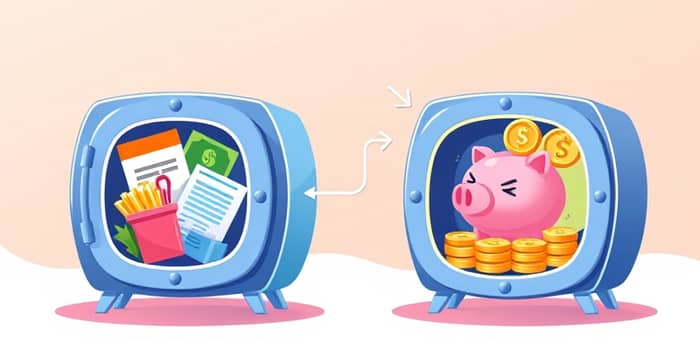Every financial journey begins with understanding basic tools that shape our money management. Checking and savings accounts serve complementary, yet distinct, roles in how we store and spend funds.
By exploring the key features and intended uses of each account type, you gain clarity on how to allocate resources for daily expenses and long-term dreams.
What is a Checking Account?
A checking account acts as your day-to-day financial hub. These accounts are designed for managing everyday financial transactions with ease and speed. Whether you are paying a bill, buying groceries, or withdrawing cash, a checking account provides the versatility you need.
Most checking accounts offer:
- Debit cards for in-store and online purchases
- Access to unlimited funds anytime for withdrawals and payments
- Direct deposits for paychecks and benefits
- Online and mobile banking for quick transfers
- Check-writing capabilities for manual payments
Additionally, many banks provide overdraft services, although this may incur fees if you exceed your balance.
What is a Savings Account?
Savings accounts are intended to hold money securely while it grows over time. You can set aside cash for short-term needs or long-term objectives, building a financial cushion for tomorrow.
These accounts let you earn interest on held balances and are ideal for emergency funds and future goals. Common features include interest accrual based on your balance, limited withdrawals (often capped at six per statement cycle), FDIC insurance up to $250,000, online transfers to your checking account, and occasional ATM access.
Key Differences Between Checking and Savings Accounts
Understanding how these account types diverge helps you tailor your finances. Checking accounts prioritize flexibility, while savings accounts emphasize growth.
Fees, Limits, and Minimum Balances
Both account types can come with fees and required minimum balances. Knowing the fine print ensures you avoid unexpected charges.
Common fee structures include overdraft fees for checking, withdrawal fees for savings, monthly maintenance fees, and ATM fees for out-of-network transactions.
- Monthly maintenance fees waived by meeting balance requirements
- Overdraft fees for exceeding checking balances
- Excess withdrawal fees on savings accounts
- ATM fees for out-of-network transactions
Most banks allow fee waivers if you maintain a specific balance or set up recurring direct deposits. Always review your bank’s fee schedule to plan accordingly.
Interest Rates in 2025
This year, the interest rate landscape continues to evolve under changing federal policies. Savings accounts now offer competitive returns that can significantly boost your funds over time.
High-yield savings providers advertise APYs up to 5%, while the national average hovers near 0.38%. Conversely, traditional checking accounts usually yield 0%–0.01% APY on balances, making them a poor choice for long-term growth.
Maximizing Both Accounts for Financial Success
To harness the strengths of each account, most experts recommend keeping everyday funds in checking and building wealth in savings. This strategy balances convenience with growth potential.
Consider automating transfers to boost savings on payday or right after a significant deposit. Consistency is key to accumulating funds without feeling the pinch.
- Set up direct deposit splits: allocate paychecks between checking and savings
- Use mobile apps to track balances and schedule transfers
- Aim to build a three- to six-month emergency fund
- Review statements monthly to adjust your saving targets
Choosing the Right Account for You
Your personal circumstances and goals will guide the best combination of accounts. If you require frequent access, prioritize a checking account with low fees and robust debit card support.
For savers focused on growth, research high-yield savings options and compare APYs, minimum deposits, and withdrawal policies. Sometimes, splitting your emergency reserve between multiple institutions can optimize insurance limits and rates.
Conclusion
Checking and savings accounts serve distinct but complementary roles in a well-rounded financial plan. By leveraging both, you can high-yield savings accounts offering 5% APY for growth while maintaining seamless access to funds.
This approach builds a solid financial foundation, blending day-to-day flexibility with long-term security. Understanding these tools empowers you to make strategic decisions and achieve lasting financial well-being.
References
- https://www.nerdwallet.com/article/banking/checking-vs-savings
- https://bettermoneyhabits.bankofamerica.com/en/personal-banking/the-difference-between-checking-and-savings-account
- https://www.santanderbank.com/personal/resources/checking-savings/difference-between-checking-savings
- https://www.huntington.com/learn/saving/differences-between-checking-and-savings
- https://www.pnc.com/insights/personal-finance/save/checking-vs-savings-accounts.html
- https://fortune.com/article/best-savings-account-rates-6-25-2025/
- https://www.cornerstone.bank/checking-vs-savings-key-differences-between-bank-account-types-why-it-matters/
- https://www.bankrate.com/banking/checking-vs-savings-accounts/










